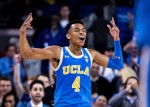Summer is here, but many Bruins won’t be having a vacation for the foreseeable future.
Twenty-one players from UCLA baseball are slated to compete in various summer leagues this offseason. The Bruins will compete in leagues from coast to coast, including the West Coast League, the Cape Cod League, the Northwoods League and for the USA Collegiate Baseball National Team.
Rising junior outfielder Garrett Mitchell was the only Bruin selected to Team USA, although rising junior right-hander Holden Powell is set to have a tryout for the team later this month.
“I feel like it’s a no brainer, (Powell) should definitely be on the team,” Mitchell said. “He won the Stopper of the Year – meaning he’s the best closer. So in my mind, why wouldn’t he be on USA Baseball as one of the best relievers in the country?”
Last summer, Mitchell finished a campaign with the Mankato MoonDogs of the Northwoods League, batting .328 with 21 RBIs in 35 games. However, Mitchell said the level of USA Baseball this summer will be significantly more challenging than Northwoods.
“The guys that I’ll be playing with and against will be the best players around the world,” Mitchell said. “There will be better pitching, hitting, defense and overall baseball. ”
The USA collegiate team is scheduled to play Cuba, Taiwan and Japan throughout July.
Mitchell also received an invite to play in the Cape Cod League this summer, but he said the choice between USA Baseball and the Cape was an easy one.
“(The decision) was not even close,” Mitchell said. “Playing in the Cape would be an honor, but USA (Baseball) is a smaller group of guys who are considered to be the top in the country. To be considered one of the top players means a lot and it’s something I’ve always wanted to do.”
Six of Mitchell’s teammates are, however, set to compete in Massachusetts for the Cape Cod League this summer. The league is comprised of summer collegiate baseball teams that hail from various towns around the Cape. Rising sophomore utility Matt McLain is playing for the Wareham Gatemen, the league’s defending champions. The Gatemen are currently third in the West Division with a 5-5-1 record.
[Related: Bruin baseball players at bat in premier summer league on Cape Cod]
Rising sophomore catcher Noah Cardenas received an invite to compete for the Yarmouth-Dennis Red Sox, while rising junior infielder Kevin Kendall and rising sophomore right-handers Nick Nastrini and Sean Mullen are teaming up on the Falmouth Commodores for the summer.
Powell will also travel to Massachusetts and is set to compete for the Cotuit Kettleers before his Team USA tryout.
Seven Bruins are competing in the Northwoods League, with teams largely based in the Great Lakes region around Minnesota and Wisconsin. Rising sophomore infielders Jake Moberg and Mikey Perez are taking the field for the MoonDogs – the same team Mitchell played for last summer.
The West Coast League, covering areas around Oregon, Washington and British Columbia, will see six Bruin recruits compete. Incoming freshman outfielder Emanuel Dean will suit up for the Walla Walla Sweets. Dean committed to UCLA as a junior in 2018 out of Servite High School in Anaheim, California.
Mitchell said summer league baseball – in whichever league the Bruins find themselves in – will benefit the entire squad as a whole.
“It gets everyone in shape, and everyone goes through a bigger grind in the summer,” Mitchell said. “In the Cape and Northwoods, guys get out everyday and play. To go out and play with different people and meet different people, it’s important to elevate your game everyday.”







